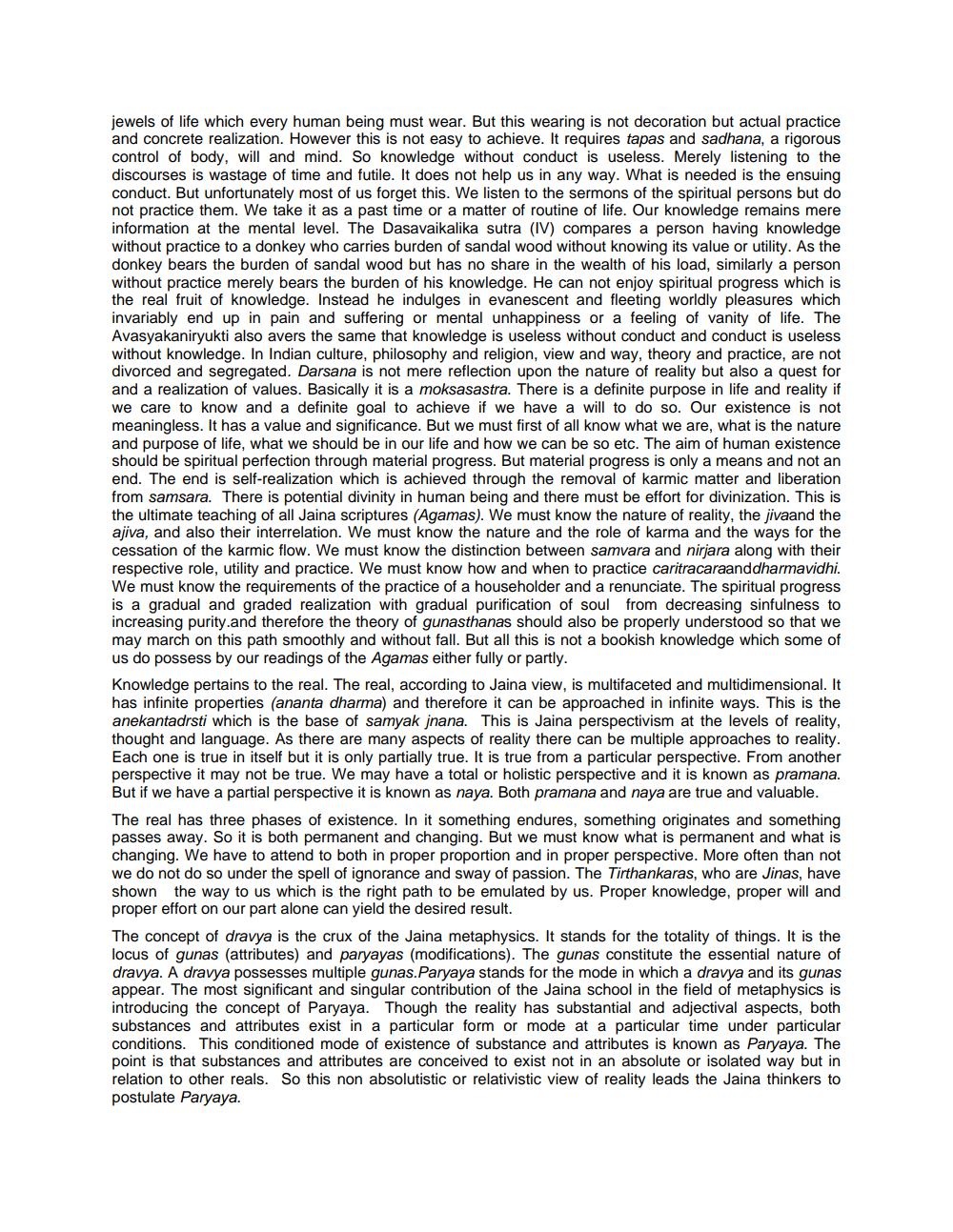Book Title: Jaina View Towards Philosophical Inquiry and Harmonious Ways of Living Author(s): S R Bhatt Publisher: ZZZ Unknown View full book textPage 6
________________ jewels of life which every human being must wear. But this wearing is not decoration but actual practice and concrete realization. However this is not easy to achieve. It requires tapas and sadhana, a rigorous control of body, will and mind. So knowledge without conduct is useless. Merely listening to the discourses is wastage of time and futile. It does not help us in any way. What is needed is the ensuing conduct. But unfortunately most of us forget this. We listen to the sermons of the spiritual persons but do not practice them. We take it as a past time or a matter of routine of life. Our knowledge remains mere information at the mental level. The Dasavaikalika sutra (IV) compares a person having knowledge without practice to a donkey who carries burden of sandal wood without knowing its value or utility. As the donkey bears the burden of sandal wood but has no share in the wealth of his load, similarly a person without practice merely bears the burden of his knowledge. He can not enjoy spiritual progress which is the real fruit of knowledge. Instead he indulges in evanescent and fleeting worldly pleasures which invariably end up in pain and suffering or mental unhappiness or a feeling of vanity of life. The Avasyakaniryukti also avers the same that knowledge is useless without conduct and conduct is useless without knowledge. In Indian culture, philosophy and religion, view and way, theory and practice, are not divorced and segregated. Darsana is not mere reflection upon the nature of reality but also a quest for and a realization of values. Basically it is a moksasastra. There is a definite purpose in life and reality if we care to know and a definite goal to achieve if we have a will to do so. Our existence is not meaningless. It has a value and significance. But we must first of all know what we are, what is the nature and purpose of life, what we should be in our life and how we can be so etc. The aim of human existence should be spiritual perfection through material progress. But material progress is only a means and not an end. The end is self-realization which is achieved through the removal of karmic matter and liberation from samsara. There is potential divinity in human being and there must be effort for divinization. This is the ultimate teaching of all Jaina scriptures (Agamas). We must know the nature of reality, the jivaand the ajiva, and also their interrelation. We must know the nature and the role of karma and the ways for the cessation of the karmic flow. We must know the distinction between samvara and nirjara along with their respective role, utility and practice. We must know how and when to practice caritracaraand dharmavidhi. We must know the requirements of the practice of a householder and a renunciate. The spiritual progress is a gradual and graded realization with gradual purification of soul from decreasing sinfulness to increasing purity.and therefore the theory of gunasthanas should also be properly understood so that we may march on this path smoothly and without fall. But all this is not a bookish knowledge which some of us do possess by our readings of the Agamas either fully or partly. Knowledge pertains to the real. The real, according to Jaina view, is multifaceted and multidimensional. It has infinite properties (ananta dharma) and therefore it can be approached in infinite ways. This is the anekantadrsti which is the base of samyak jnana. This is Jaina perspectivism at the levels of reality, thought and language. As there are many aspects of reality there can be multiple approaches to reality. Each one is true in itself but it is only partially true. It is true from a particular perspective. From another perspective it may not be true. We may have a total or holistic perspective and it is known as pramana. But if we have a partial perspective it is known as naya. Both pramana and naya are true and valuable. The real has three phases of existence. In it something endures, something originates and something passes away. So it is both permanent and changing. But we must know what is permanent and what is changing. We have to attend to both in proper proportion and in proper perspective. More often than not we do not do so under the spell of ignorance and sway of passion. The Tirthankaras, who are Jinas, have shown the way to us which is the right path to be emulated by us. Proper knowledge, proper will and proper effort on our part alone can yield the desired result. The concept of dravya is the crux of the Jaina metaphysics. It stands for the totality of things. It is the locus of gunas (attributes) and paryayas (modifications). The gunas constitute the essential nature of dravya. A dravya possesses multiple gunas. Paryaya stands for the mode in which a dravya and its gunas appear. The most significant and singular contribution of the Jaina school in the field of metaphysics is introducing the concept of Paryaya. Though the reality has substantial and adjectival aspects, both substances and attributes exist in a particular form or mode at a particular time under particular conditions. This conditioned mode of existence of substance and attributes is known as Paryaya. The point is that substances and attributes are conceived to exist not in an absolute or isolated way but in relation to other reals. So this non absolutistic or relativistic view of reality leads the Jaina thinkers to postulate Paryaya.Page Navigation
1 ... 4 5 6 7 8 9 10 11
